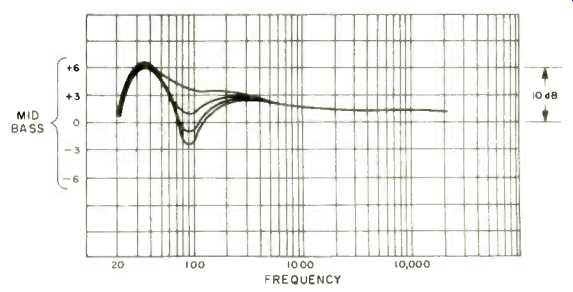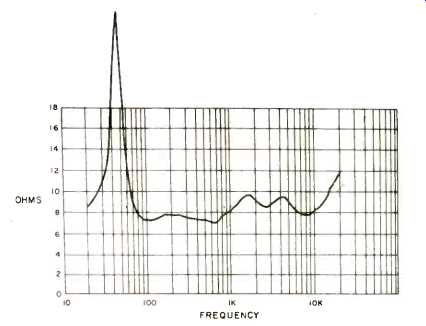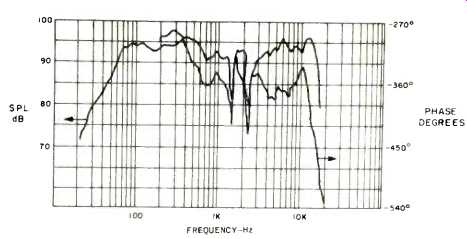
MANUFACTURER'S SPECIFICATIONS
System Type: Acoustic suspension with active equalizer.
Frequency Response: 30 to 20,000 Hz. 2 dB (with equalizer). Power Rating: 100 watts. Impedance: 8 ohms. Crossover Frequencies: 800 and 4000 Hz.
Dimensions: 25 1/8 in. H x 15 in. W x 10 3/8 in. D.
Weight: 30 lbs. each.
Price: EQS speaker, $ 180.00; EQE equalizer, $ 125.00; EQ5 system (two EQS speakers and one EQE equalizer), $475.00.
The use of program equalization to enhance or diminish selected portions of the frequency range is so commonplace in sound processing that it is referred to in engineering parlance only by the letters EQ. The Altec Sound Products Division of University Sound has borrowed this terminology to name their equalized speaker system, Concept EQ. The primary purpose of the electronic equalization supplied with this speaker system is not, however, the artistic embellishment one seeks in a recording studio. Rather, it is intended to make the sound more natural when heard in a conventional listening room.
The speakers are relatively small, measuring 15 x 10 5/8 x 25 inches. They are finished on four sides in walnut and have a sculptured black foam grille. Electrical connection is made to two push type terminal posts in a recessed cavity-in the rear. No speaker controls exist on the cabinets, and the terminals are clearly marked by both letters and color.
The foam grille appears to be bonded with adhesive to a more solid grille in front of the speaker cones. This reviewer is firmly in favor of such a solid backing which protects the speaker cones from mechanical damage from such causes as the fingers of inquisitive toddlers. However, a gentle tug on the foam is sufficient to break the adhesive bond, leaving an unsightly foam edge protruding. Efforts at poking the foam back into place are fruitless. The natural household solution to such a problem would be to glue it in place, which is acoustically unsatisfactory. Therefore, this reviewer recommends neither pulling on the foam nor handling the speaker by grasping the solid-appearing foam grille.
The electronic equalizer is a two-channel, solid-state unit mounted in an attractive walnut cabinet. A two-pin a.c. plug is supplied with a generous amount of cord. No on-off switch is provided since the unit is meant to plug into a pre-amplifier utility outlet and be turned on and off with the preamplifier. Four front panel controls are multiposition switches. Three of the controls are for adjusting equalization of Low, MID BASS, and HIGH frequencies. The fourth switch is for selecting one of three modes of operation, equalizer OUT, which bypasses all equalization; equalizer IN, which places the equalization in speaker reproduction only, and TAPE which equalizes speaker reproduction and tape recorder playback but does not equalize signals which the preamplifier may send to a tape recorder.
A very complete service manual is provided for the equalizer, a good thing in view of the rear panel complexity of contemporary receivers and preamplifiers and the requirement to wire into and out of the tape monitor positions.
Care is needed to assure that proper connection exists, and this is no place for hasty hookups. An alternate solution, not mentioned by Altec and which quickly presents itself, is to place the equalizer between the preamplifier and power amplifier. We do not recommend doing this even though the specifications of the equalizer are adequate to do an excellent job in this position. The reason for this caution is an equalizer turn-on and turn-off output voltage transient which will produce an annoying sound and possible speaker damage if a d.c.-coupled power amplifier is used.
Technical Measurements

Fig. 1--Equalizer response for low and high frequency control.

Fig. 2--Equalizer mid bass control.
The active equalizer supplied with the concept EQ 5 could be looked upon as a very special tone control circuit intended to complement the performance of this particular speaker design. The Low FREQUENCY switch equalizes response in the 20 Hz to 150 Hz band with the major effect at 30 Hz. The MID BASS switch gives additional control at 80 Hz and the HIGH FREQUENCY switch works primarily above 5 kHz. Both the LOW and HIGH FREQUENCY Switches have positions marked 0,-3, and-6. The MID BASS has the five positions of +6, +3, 0,-3, and-6. Because of the substantial interaction of the LOW and MID BASS response, it is unreasonable to plot all possible combinations. Figure 1 shows the separate effects of the LOW FREQUENCY and HIGH FREQUENCY controls with the MID BASS set to its 0 position. The curves are separated by 10 decibels for clarity in this plot. There is actually nearly a 2 decibel increase in level when the equalizer is switched into operation, which adds some psychological effect in a before-after comparison. Figure 2 is a measurement of the MID BASS control alone with the LOW FREQUENCY Control set to-6 and the HIGH FREQUENCY control to 0. The effect of this control at 80 Hz is quite evident.
Harmonic distortion at 1 kHz and one volt rms measured 0.03 per cent and was composed primarily of second harmonic components, which is well within Altec's specification. Signal to average noise power in a 20 kHz band measured 75 dB for a rated output of 1.5 volts rms and was mostly 60 Hz and 120 Hz with a stronger low frequency flicker component which proved to be inaudible in the recommended hookup.
The Concept EQ 5 is rated as an 8 ohm unit, and this is quite close to measurement shown in Fig. 3. The maximum impedance is 31 ohms at 54 Hz.
The anechoic frequency response was measured without the equalizer, since the effect of equalization may be seen by referring to Figs. 1 and 2. The one-meter, one-watt on axis response for this speaker is shown in Fig. 4. Even without equalization, the low frequency response is relatively uniform down to below 70 Hz where it then rolls off at nearly the expected 12 dB per octave. The narrow dips in amplitude at 1400 Hz and 2200 Hz are due to driver interaction as evidenced by the phase response. The response is substantially non-minimum phase only in the range from 1 kHz to 3 kHz and at around 9 kHz.
An unusual effect was noticed as the speaker was rotated. Figure 5 shows the response at an angle of 15 degrees off axis, corresponding to this speaker being used as a right channel of a stereo pair. Figure 6 is the measurement for the other 15 degree position corresponding to a left channel. Note the difference in phase calibrations between Figs. 4, 5, and 6. Unlike most speakers, the 15 degree off-axis response is better than its on-axis response.
Sensitivity is quite good and a sound pressure level of 94 dB is maintained for one watt input over most of the usable frequency range.
The three-meter response is shown in Fig. 7 for a direct on-axis position and a 30 degree left stereo channel position. This is the frequency response of the first 10 milliseconds of sound when the Concept EQ 5 is placed on a rug floor and flat against a wall. The listening position is three meters in front of the speaker and one meter above the floor. No other room reflection components exist except the floor, ceiling and wall against which the speaker is placed. This is thus the "early" sound for this configuration. The equalization was set to a position of -3 for the Low FREQUENCY, O for the MID BASS, and 0 for the HIGH FREQUENCY. The reason for choosing this mounting position is based on the results of the listening test performed prior to any technical measurement. The curves in Fig. 7 are displaced 10 dB for clarity of presentation.

Fig. 3--Impedance plot.

Fig. 4--One-meter anechoic response measured on-axis with one watt input.

Fig. 5--One-meter anechoic response measured fifteen degrees to the left
of center with one watt input.
Fig. 6--One-meter anechoic response measured fifteen degrees to the right of center with one watt input.
Fig. 7--Frequency response due to first ten milliseconds of sound in a preferred room position measured at three meters. Curves displaced 10 dB for clarity.
Figure 8 is the measured harmonic distortion for the musical tones E1, A2, and A4. The mid frequency distortion is extremely low for a speaker in this price range right up to the rated 100 watts. The low bass distortion is also quite low and remains below 5 per cent at levels as high as 100 dB SPL. However, the rapid rise of odd harmonic warns that the driver is beginning to run out of capability at this level.
In view of the substantial bass boost available in the equalizer, care should be exercised if an amplifier rated for more than 100 watts is used. The sensitivity of this speaker is such that a 30 to 50 watt amplifier should give all the sound normally required.
Fig. 8--Harmonic distortion for the musical tones E1, A2, and A4.
In the signal suppression test, a musical note at one level is mixed with white noise at a 20 dB higher average level. The power in both signals is then raised until measurement indicates that the tone is being modulated by the noise so as to be reduced from its value before noise was added. It is a measure of the ability to handle crescendos. In the Concept EQ 5, a 440 Hz A4 note was reduced 'h dB by noise with an average power of 60 watts and peaks approaching 600 watts. At 3 kHz, 1 dB suppression occurred at peaks of 528 watts and average of 50 watts. The peak noise power at which 3 kHz began to show a reduction was 33 watts. The conclusion is that crescendos can be handled in excess of 100 watts, but some cross modulation will occur above 33 watt peaks. This is still quite loud for a speaker with the efficiency of the EQ 5.
Fig. 9--IM of A4 by E1 mixed 1:1.
Figure 9 is the IM distortion of the musical tone A4 by E, fed at equal levels. A power level of one watt at each of these frequencies produces a voltage corresponding to an average power of 4 watts if a single tone with the same peak voltage were to be applied. At this level the IM is 2.5 per cent. Most of the IM in this speaker is due to phase modulation for such low frequencies.
Figure 10 is the polar energy response. The unusual dissymmetry which produced the effects shown in Figs. 5 and 6 is also evident in this plot. Both Concept EQ 5 units had this behavior in the plane of symmetry normally used to make anechoic measurements. The polar pattern suggests that much of the higher frequency sounds will be relatively directional with some changes in timbre with angle. The substantial low frequency response of the on-axis measurement of Fig. 4, together with the relative omni-directionality of lower tones implies that room sound may be richer in lower frequency reverberation than higher frequency reverberation, particularly if there is any substantial drapery.
This, together with the bass boost of the equalizer, may make the sound bottom-heavy in some rooms. The correction is to use conventional preamplifier tone controls if this is found to be the case.
Fig. 10--Polar energy.
Figure 11 is the time-energy plot, which is the response to a shaped pulse band limited to contain only frequencies from d.c. to 20 kHz. This is an on-axis measurement. The contribution at 4.3 milliseconds is at a time which would correspond to a cabinet back wall reflection for midrange components. The midrange dips in Fig. 4 correlate reasonably well with the arrival times of Fig. 11.
Fig. 11--Energy-time response to a perfect pulse band limited d.c. to 20 kHz.
Listening Test
A properly built acoustic suspension system will put out a lot of bass if you drive it hard, and that is exactly what the Concept EQ 5 does. The close to 17 dB of 30 Hz boost available when switching the equalizer on can make you run to save the crockery when a really low note comes along.
In anything but a center floor mounted position, the bass is much too overpowering at the maximum equalizer position.
Experimenting with speaker location soon made us settle on a wall mounting position.
Placing the speakers up in a bookshelf configuration did not produce stereo imagery acceptable to this reviewer. The problem seemed to be due to polar beaming which caused a stereo shift and a timbre change with change in listening position. It was not until the units were placed down on the floor that the sound imagery was reasonable accurate. The majority of listening was done with this wall mounted floor position.
The most balanced sound appeared to occur for this configuration with an equalizer Low setting of -6, a MID BASS of -3 and a HIGH of 0. At no time did the top end require any roll-off, although in a moderately "live" room the HIGH control might prove useful. Certain instruments, such as kick drum and tom-tom, still seemed "bumpy" even with this minimum bass compensation, but a minor touchup with the normal preamplifier tone controls set that right.
After listening to this combination for a while, it is a shock to switch the equalizer out. I had privately wondered at the wisdom of a bypass switch position, as one presumably had purchased the equalizer and speakers as a set. When you switch the equalizer out, it is a good reminder why you bought that configuration in the first place. Something like the early days of stereo when you invited a neighbor over to listen and just as he got used to the sound you switched to "mono" to see the look on his face.
Much of the apparent sound image appears to come from the position of the speaker or in the stereo "picture window" plane containing the two speakers. It gives the impression to this reviewer of a foreshortening of the sound image.
The Concept EQ 5 is certainly capable of delivering a lot of sound and backed up by a 50 to 100 watt amplifier makes an excellent moderately priced choice for rock music.
-Richard C. Heyser
(Audio magazine, Feb. 1974)
Also see:
Altec Lansing 511 Speaker (Apr. 1991)
Klipschorn Loudspeaker (Nov. 1986)
= = = =